#pre-incan culture
Explore tagged Tumblr posts
Text
Inca Maiden
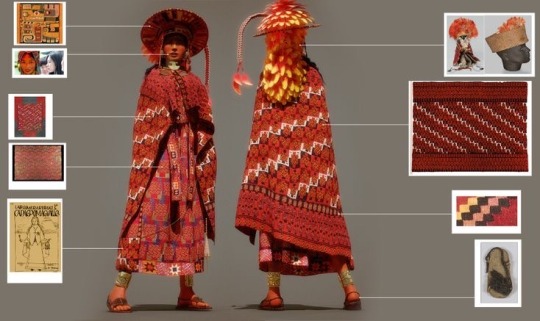
The clothes shown here correspond to the Chuquibamba style, an allied kingdom of the Inca empire

The acllas in the Tahuantinsuyu*, were the women of greater cultural preparation. These women were recruited and then chosen to be prepared in the so-called Acllahuasis, which were in charge of the Mamaconas, as stated by the chronicler Bernabé Cobo:
"... the acllahuasi or house of chosen women was an institution that brought together the Mamaconas or Ladies Mothers who acted as teachers and a credible number of girls entering a closing regime between the ages of ten and twelve. They were collected as a tribute among the most noble and beautiful ... "
Source
*Empire of four (the Inca empire)
#incan#inca#inca culture#incas#Inca Maiden#Maiden#Acclahuasi#Mamacona#tahuantinsuyu#Chuquibamba#incan art#pre columbian#peru#inca empire#ladie mothers#ancient history#ancient america#priestess#royality#noble woman#aclla#acllas
34 notes
·
View notes
Text
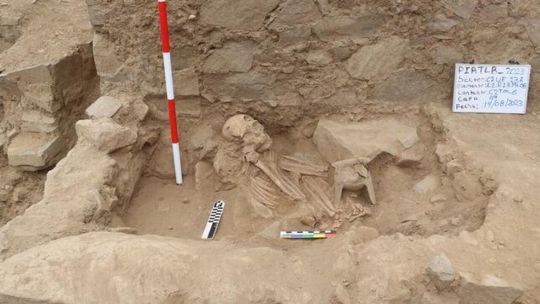
Pre-Incan Site for Ancestor Worship Found in Peru
A team of Peruvian and Japanese archaeologists has unearthed a pre-Hispanic archaeological site in northern Peru dedicated to ancestor worship, with burial chambers, human remains and ceramic offerings.
"We have discovered an archaeological site of the Wari period with an antiquity of between 800 to 1000 years AD" in the Cajamarca region 900 kilometers (560 miles) north of Lima, Japanese archaeologist Shinya Watanabe told AFP on Saturday.
"Two burial chambers with pits for placing mummies and offerings to the ancestors were found at the site," the expert said.
Each of the burial chambers contains two levels, and both have five niches in the walls that contain offerings such as mollusk shells, ceramic fragments and a tripod dish with three conical supports.
"It is a great find because the archaeologists were looking for evidence of the Wari culture," said Watanabe, who is a professor at Nanzan University in Japan.
A bundle containing a female character, a black Wari ceremonial vessel, two musical ceramic wind instruments, and two copper fasteners were also found.
The discovery occurred in the Jequetepeque valley in the province of San Miguel in Cajamarca, a region that abuts Ecuador.
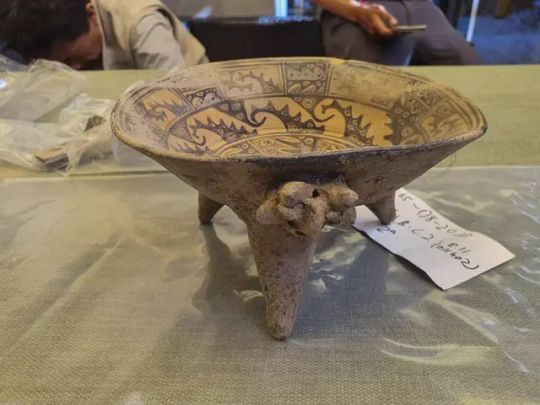

"Many people of multiple origins lived here. It was a ceremonial center dedicated to the cult of the ancestors," Watanabe said.
Judith Padilla, head of Cajamarca's culture office, said the findings allow for an understanding of "the lifestyle and ritual practices" of the ancient societies that inhabited the region.
The Wari culture survived between the 7th and 13th centuries over territory that is present-day Peru, but by 1100 AD the Wari were conquered by the rising Inca empire.
The discovery was made by the Project of Archaeological Investigation (PIA) Terlen-La Bomba and it occupies about 24 hectares (60 acres).
The Ministry of Culture indicated that the main objective of the research is to understand the socio-political system of the Cajamarca culture during the Middle Horizon (900 to 1000 years AD) and its relationship with the Wari culture.
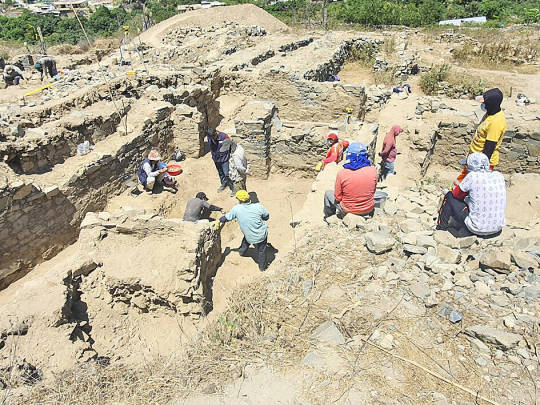
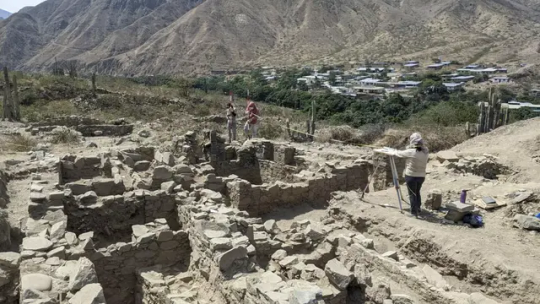
#Pre-Incan Site for Ancestor Worship Found in Peru#Cajamarca region#ancient grave#ancient tomb#ancient artifacts#archeology#archeolgst#history#history news#ancient history#ancient culture#ancient civilizations#wari culture
128 notes
·
View notes
Note
Are the Urswali-Dain people/the dainlands apart of Imperial Wardin?
No, Imperial Wardin is relatively small (though in-universe is pretty damn big. Most societies are small scale, singular state-entities that control this much territory are an outlier.). It is Interactive with some of the Dain-speaking populations on the other side of the Viper (and has some wholly unrealized expansionist designs against them), but no territorial control whatsoever. (Also there's been a lot of revision since they were last brought up, Urswali do not speak a Dain language family tongue).

A lot of fictional pre-modern empires are modeled after The Big Ones with massive territorial claims (or to be real, Rome specifically rather than other Big Ones like the Mongol or Incan empires) so I think that a lot of people have that in the back of their minds but like. Nah it's a relatively small space of land (my current estimate is like..... about the size of contemporary Spain?? give or take?????). The models I've referenced for designing its structure and logistics are geographically smaller states (I would consider the Aztec, Mali, and Maybe the Athenian (via Delian League) states to be decent analogues in very different ways, though none are actually like. Close analogues.).
It's composed of eight provinces all deferential to the Usoma ruling out of the Wardin province- a core alliance between two former kingdoms and a city-state (Wardin, Ephennos, Godsmouth/Odkottonos respectively) two that were fully conquered and made into provinces in state-formation (Erub and Erubinnos), and two former 'tributary' states that have fully lost their self-governance and are now provinces (Jatsait and Lobera). Each province is comprised of a core territory (usually a former kingdom or city-state) and its own tributaries (conquered/controlled non-citizen regions that retain a degree of self governance in return for economic tribute), with Lobera effectively being the biggest province via having most of the northern half of the region as a tributary. Finnerich was conquered as a tributary in a particularly aggressive manner (its self-governance was Extremely nominal and it probably would have been fully absorbed as a province if everything went nice and smooth for the Imperial Wardi side) but is completely independent at this time.
Non-Wardi ethnic groups native to the region and existing wholly within its claimed territory are the Hill Tribes, Cholemdinae, North Wardi, and Jazait. Some Wogan groups exist within its claimed territory, but most of the population is further east. 'Wardi' as a quasi-ethnic descriptor is very, very complicated, and what distinguishes someone being of Core Wardi identity and not is entirely due to the historical trajectory of assimilation, rather than actual close shared ancestry. The core 'Wardi' group is composed of 10 major tribes that self-assimilated or were assimilated into this shared identity, while the Cholemdinae, North Wardi, and Wogan groups represent descendants of other related tribes that did not assimilate (on population rather than individual levels). So like as an example- the South Wardi (mostly the former Wardinae tribe) share the Most recent common ancestry with the Cholemdinae, and less recent common ancestry with the Ephenni. On POPULATION levels, the South Wardi and Ephenni both culturally/religiously assimilated while the Cholemdinae did not, and therefore are both 'Wardi' (with some sense of subcultural identity) while the Cholemdinae are still Cholemdinae.
'Imperial Wardi' identity complicates this further, in that it is based on religious affiliation, Core cultural practices, and legal citizenship rather than ethnicity (and includes several major foreign migrant/diaspora groups). For example, the Yuroma-Wardi population is mostly a diaspora group from outside the region, but are part of the Imperial Wardi cultural sphere due to shared religious practices, cultural integration (with retained subcultural identity and practices), and citizenship, as well as a fairly long history in the region. Or alternatively, some individual people/groups of Cholemdinae, North Wardi, Wogan and/or Hill Tribes descent are Imperial Wardi as citizens and cultural-religious adherents, while not being 'Wardi'. Contemporary Wardi identity is now treated as a specific ethnic identifier, but Imperial Wardi identity is (at least ostensibly) accessible regardless of ethnic origin.
So that might clear up the full extent of the state/it's cultural sphere lol.
36 notes
·
View notes
Text
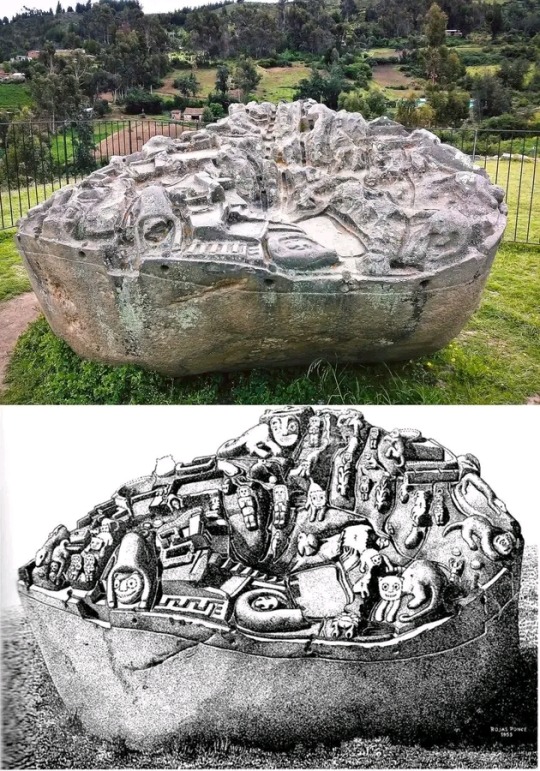
About two meters long, and four meters wide, the mysterious Sayhuite monolith is an enormous rock containing more than 200 geometric and zoomorphic figures, including reptiles, frogs, and felines. Found at the top of a hill named Concacha, the stone was sculpted as a topographical hydraulic model, complete with terraces, ponds, rivers, tunnels, and irrigation channels. The functions or purposes of the stone are not known, but researchers believe the monolith was used as a scale model to design, develop, test, and document the water flow for public water projects, and to teach ancient engineers and technicians the concepts and practices required. The rock was "edited" several times, with new material, either altering the paths of the water or adding routes altogether.
While the creators remain a mystery, the monolith provides archaeologists with insight into the culture of the pre-Columbian population. Archaeologists have determined that the site was an Incan religious center, where rituals and ceremonies for the worship of water was conducted. The monolith is an important clue to this, since it depicts a water-like flow between the carvings. Modern-day engineers also speculate that the monolith is a depiction of the irrigation systems present within the Incan culture.
-John Gotti's Era
22 notes
·
View notes
Text

Viracocha, the Incan lord of creation. Before time there was only darkness. Within this darkness lay a watery chaos, lake Titicaca. This chaos stirred and out emerged the first of all things, Viracocha. With his wife Mama Qucha, Viracocha spawned the sun god Inti and the moon goddess Mama Quilla, from his hand spilled the stars of the night sky. Viracocha made the earth itself, creating the valleys, mountains and seas by which life called home. Viracocha manifested time, ordering Inti and Mama Quills to move across the sky. Viracocha gathered the stones strewn across his lands, and as they rested in his hands he blew on them, instilling within them life. These stones became giants who raged against the earth and held no intelligence of their own. Disappointed, Viracocha sent a flood and wiped away the giants. Viracocha tried once again, this time he used smaller stones, bringning about the human race. Viracocha now satisfied with his creation, left the mortal world, leaving it in the care of humanity and the gods. Despite his departure, Viracocha regularly visited the earth in the form of a beggar, teaching the masses about the world they inhabited. Viracocha embodied the wind and storms and was heavily associated with the sea, possibly in relation to the pre creation chaos but it could also be the result of his wife Mama Qucha, who embodied the sea and the life within it. The inca revered Viracocha as the animate force of the universe, the substance by which all was created.
Viracocha was the highest and most worshipped god among the Incas. The worship of Viracocha didn’t originate within the Incas however, as he does predate the Incan civilization themselves, likely originating from their predecessors. However it was among the Inca’s where Viracocha grew to his pinnacle of popularity, he was the center point of Incan worship, with the sun god Inti, an incredibly popular god in his own right, was only second to Viracocha. As the Incan civilization grew they absorbed neighboring peoples like the Nazca and the Ichma, with their chief god counterparts, Kon and Pachacamac being inducted into the Incan pantheon. The Nazca’s Kon in particular became close with the worship of Viracocha. Originally both Kon and Pachacamac were introduced as sons of the sun god Inti, both of them keeping their attributes as creator gods they held in their native lands. However Viracocha’s worshippers began to associate Kon more and more closely with Viracocha, ultimately conflating the two and rendering Kon as a manifestation of Viracocha, Cuniraya Huiracocha. Cuniraya embodied Viracocha’s aspect as a trickster god, with his form as a beggar being used to irritate the gods. With Viracocha’s popularity came a multitude of names and titles, such as Pachayachicachan “teacher of the earth”, and T'iqsi Wiraqocha. One of Viracocha’s epithets, Kontiki, is the result of further conflation between Viracocha and Kon. The presence of the word “Tiki” in some of Viracocha’s names lead some to believe that the Polynesian peoples descended or were influenced by indigenous South American cultures, influencing the creation of the Polynesian first man Tiki. However dispute this theory gaining much traction it’s been proven through both archaeology and DNA analysis that this theory was false. According to the records of the Spanish colonists, they alleged that Viracocha among many other gods were believed by the Incans to be white or Caucasian witb beards. A similar claim was made by the Spanish colonists who colonized mesoamerica with Quetzalcoatl. Not a single piece of evidence exists to support the idea that the Incans believed this, in actuality it was an attempt made by the Spanish to aggrandize and appropriate themselves in Incan customs to further push colonization. Among the Spanish’s records of Incan mythology, they claim that Viracocha walked on water, that he traveled the earth and taught humanity, and that he would reappear during times of need. These have intrigued scholars with its mirroring of many of the traits shared by Jesus, it’s unclear if it comes from an attempt to convert the Incas or if it’s an actual belief the Incas had. However in conjunction with the Spanish’s attempt in changing Viracocha’s race it is more likely that it came from an attempt to Christianize the Incans. Despite this there are some parallels within both Incan and South American mythology, as South American gods like Kon were depicted departing the earth from the sea, it’s known that Incas did believe that Viracocha traveled the earth in human form as a trickster which could be equated with teaching humanity. The development of Viracocha likely branched off from a common ‘staff god’ ancestor, with fellow branches being Kon, Pachacamac, and the Lanzon deity of the Chavin. The image of a staff god traced back to 2500 BC, a possible view of the ancestor of Viracocha.
#art#character design#mythology#deity#culture hero#viracocha#huiracocha#wiraqucha#kontiki#inca mythology#south america#South american mythology#peru#creator god#storm god#sun god#sea god#ocean god#water god#time god#trickster god#indigenous
2 notes
·
View notes
Text
23 notes
·
View notes
Text
on indigenous peoples day
lets unlearn the idea that western societies were more civilized and indigenous societies needed instruction.
aztecs had human sacrifices to gods. but spanish people burned people at the stake for their god during the inquisition. incas colonized pre incan peoples. spanish people colonized a whole continent and engaged in chattel slavery. these werent less developed cultures. they were newer cultures. they had techologies the spanish didnt have and the spanish had other tech. the spanish were objectively more barbaric and civilization isn't a cure for barbarism. civilization brings barbarism and order in equal measure.
4 notes
·
View notes
Text
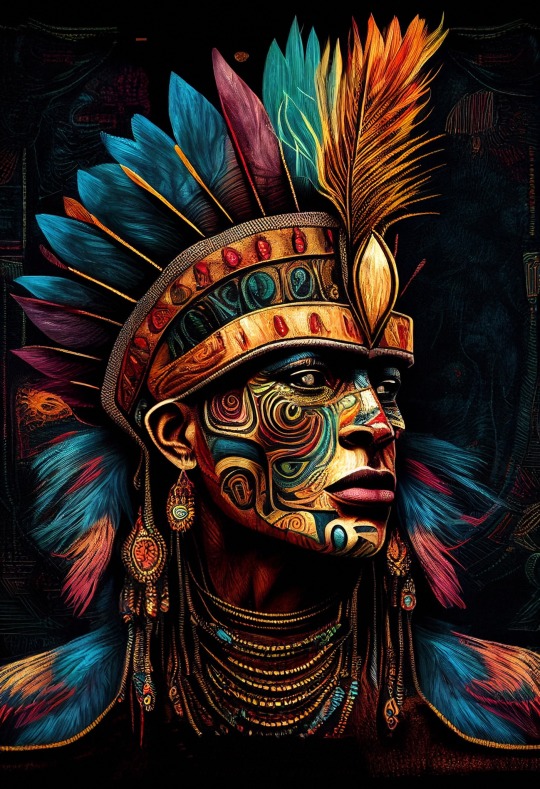
Viracocha: The Great Creator God of the Incas Talon abraxas
THE LEGEND OF VIRACOCHA
Legend tells us that a primordial Viracocha emerged out Lake Titicaca, one of the most beautiful and spiritually bodies of water in the world and located next to Tiwanaku, the epicenter of ancient pre-Hispanic South American culture, believed location of spiritual secrets found in the Andes. Viracocha is intimately connected with the ocean and all water and with the creation of two races of people; a race of giants who were eventually destroyed by their creator, with some being turned into enormous stones believed to still be present at Tiwanaku.
He re-emerged from Lake Titicaca to create the race most associated with humans as we understand them today. Satisfied with his efforts, Viracocha embarked on an odyssey to spread his form of gospel — civilization, from the arts to agriculture, to language, the aspects of humanity that are shared across cultures and beliefs.
While written language was not part of the Incan culture, the rich oral and non-linguistic modes of record-keeping sustained the mythology surrounding Viracocha as the supreme creator of all things. Now much-visited ruins, the distinct structures, and monoliths, including the architecturally stunning Gateway of the Sun, are testimony to the powerful civilization that reached its peak between 500-900 AD, and which deeply influenced the Incan culture.
17 notes
·
View notes
Note
Mochi! You okay with discussing about the economical system the Aztecs and Incas?
I’m really curious what differed from the two.
From what I know from my fathers explanation, the system the Incas had was much better than monarchy because it wasn’t the top that saying “give this quantity” but more like “what can you give?”
And also because the Incas were more or less isolated, they didn’t really exchange goods with other cultures, there was no real market for the outside so they didn’t stocked up beyond themselves. But hey I still need to read more about that.
While I focused on Mesoamerica during school, I focused primarily on culture and social hierarchies (I was very interested in religion), so I don't actually know a lot about either of their economic systems very well.
A quick fun fact, the correct term is actually Inca, it's used as both plural and singular. For the Aztecs, depending on who you ask and what you're specifically referring to, the Aztecs were the Culhua-Mexica or Mexica. Mexica often refers to the people that first established Tenochtitlan, Texcocah and Texcoco, who made up the rules of the entire empire. Typically, this is who most people refer to when talking about "Aztecs," as the term Aztec also might have included the peoples they conquered, though they are using more correct terms in academia now. They were an empire that included other Nahuatl (the language family and people of Southern Mexico and Central America). The term Aztec comes from a myth that the Mexica fled from their original home of Aztlan from the North, though that's a topic for another day, as there's a lot of debate surrounding it. There's a lot more nuance about it, and the issue of all Nahuatl people in Central Mexico being referred to as Mexica by the Spanish. It's the reason Mexico is called such, though the name doesn't reference the other indigenous of Mexico, such as non-Mexica Nahuatl people and the Maya. But that's like a completely different topic.
I do think it's a disservice to call the Inca isolated, as it sort of brushes over the numerous amount of tribes that made up the empire. It was "isolated" in that the Pacific ocean and the Andes mountains didn't allow for easy outside travel, but the empire is made of up a variety of pre-Incan tribes. Some of them were assimilated into the empire, while others were most likely outright destroyed. We have very little traces of pre-Incan people though, so we don't know much about them.
I dug through my old notes and class slides to try and find some stuff, and below gives a good idea of pre-Incan peoples.

I'll have to get back to you on the economy later, as I have to dig through my old stuff to find the info on it.
7 notes
·
View notes
Text
Publications of the New World
The James Smith Noel Collection has closed out another exciting exhibit, this time the topic was the New World of the Americas as experienced by Europe and other explorers. The exhibit: Exploration of the New World features the culture and intriguing history of Central and South America as it was experienced in the resources produced in the 17th, 18th, and 19th centuries. We welcomed visitors to the mysterious, ancient rituals of the Pre-Columbian Mayans, the Aztecs of Mexico, and the Incas of Peru. We also showcased the advancements in architecture, science, and community development while marveling at the natural beauty of the regions.


One of the cases displayed a fascinating book which was originally published in Spanish and later translated into English. The edition house in the Noel Collection was published in 1688 of The royal commentaries of Peru, : in two parts. The first part Treating the Original of their Incas or Kings: Of their Idolatry … by Garcilaso de la Vega. Vega wrote a pivotal account of Incan history. Vega has a unique personal connection to the Incan world being a descendant of royal Incan lineage. He was half Spanish and Incan, his father being Spanish, and he chronicled Incan history, culture, and destruction as a result of the Spanish conquest. We featured a portion of text that discussed the minerals, precious metals, and natural resources found in Peru, such as, gold, silver, and mercury or quicksilver.

Vega was born as Gómez Suárez de Figueroa in April of 1539, and became known as El Inca. He ventured to Spain when he was 21 where he obtained an informal education and remained until his death in April of 1616. His father died in 1559 and Vega relocated to Spain two years later to seek acknowledgement as the natural son of the Spanish conquistador. His paternal uncle became his protector. While he primarily wrote on the Incan civilization, Spanish conquest, and an account of De Soto’s exploration of Florida.
Gómez Suárez de Figueroa was born in Cuzco, Peru; his father is recorded as being Sabastian Garcilaso de la Vega y Vargas, a Spanish captain, and his mother was Palla Chimpu Ocllo. When his mother was baptized after the fall of Cuzo and renamed Isabel Suarez Chimpu Ocllo, she was descended from Inca nobility, the daughter of Tupac Huallap and granddaughter of Tupac Yupanqui. Vega’s parents were not married in the Catholic church, resulting in his birth being considered illegitimate and he was given his mother’s surname. Vega was a child when his father left and married a younger Spanish noblewoman. His mother married and had two daughters. His first language was Quechua but learned Spanish as a child.


After moving to Spain, he received a European education and the works he produced was considered to have great literary value. He traveled to Montilla and met his father’s brother, Alonso de Vargas, who took him as his protector to help Vega make his way. He traveled to Madrid and petitioned the crown for acknowledgement. He was allowed the name of Garcilaso de la Vega, or "El Inca" or "Inca Garcilaso de la Vega" due to his mixed heritage. He had first-hand experience of the daily-life of the Inca life which heavily influenced his writings. His education allowed him to accurately describe the political system, labor force, and social life of the Incan empire.

Vega, Garcilaso de la (1688) The royal commentaries of Peru, : in two parts. The first part Treating the Original of their Incas or Kings: Of their Idolatry … London: Printed by Miles Flesher … https://bit.ly/3UxrtdH
Exhibit link: https://bit.ly/3y7k657
9 notes
·
View notes
Text
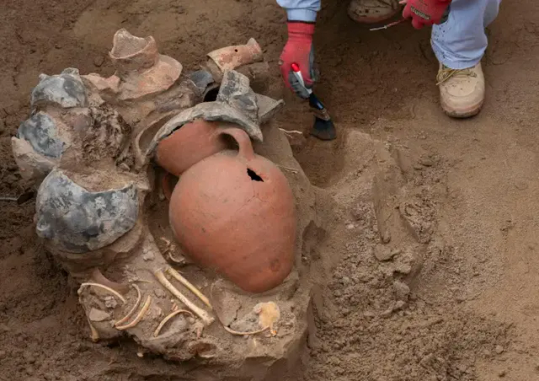
Eight Mummies and Pre-Inca Artifacts Discovered in Peru
Peruvian gas workers made an astonishing discovery beneath the ancient streets of Lima this week — uncovering eight mummies and a number of Pre-Inca artifacts.
“We are recovering those leaves of the lost history of Lima that is just hidden under the tracks and streets,” said Jesus Bahamonde, an archaeologist with Calidda, the company that distributes natural gas to the 10 million residents of Peru’s capital city.
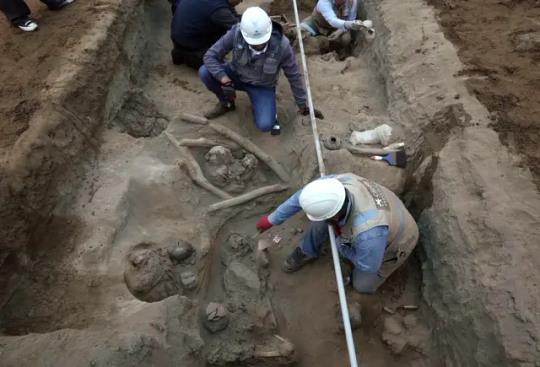
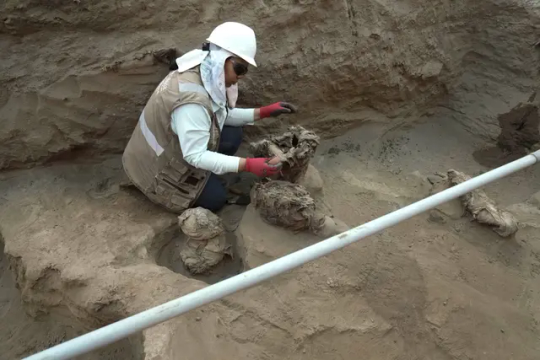
Since the company began expanding its gas line system nearly two decades ago, they’ve racked up more than 1,900 archeological finds — including mummies, pottery, and textiles, Bahamonde said.
In the most recent discovery, the eight mummified males were found bundled up in the trench, wrapped in cotton cloth and tied with ropes braided from vines. Workers found the bodies about a foot below the ground.
Archeologists with the gas company believe the men belonged to a pre-Inca culture called Ichma, which formed around A.D. 1100 and flourished in the valleys around Lima until it was absorbed into the Inca Empire in the late 15th century.
Roberto Quispe, an archeologist who worked in the trench, sad the mummified bodies are likely two adults and six minors.
Lima, now an urban economic hub, has been occupied by humans for more than 10,000 years, from the Pre-Incan cultures to the Spanish conquistadors who claimed the land in the 16th century.
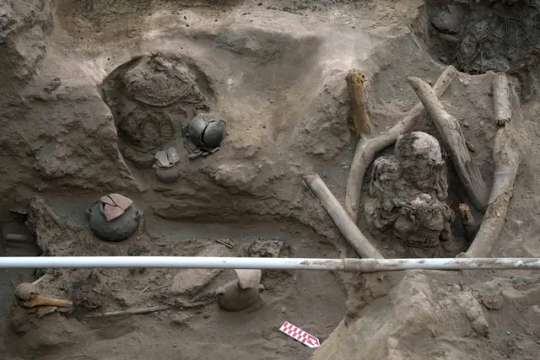
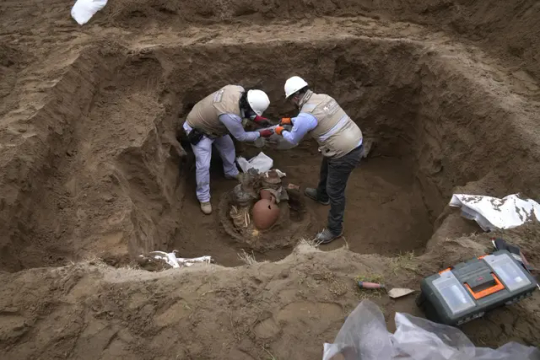
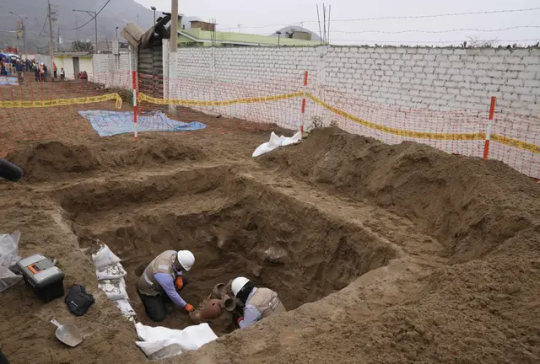
Many archeological finds have proven to be from more recent times.
In 2018, Quispe and other archaeologists working in the La Flor neighborhood found wooden coffins holding three Chinese immigrants buried in the 19th century.
The bodies were found alongside opium pipes, hand-rolled cigarettes, shoes, Chinese playing cards, a Peruvian silver coin minted in 1898 and a certificate of completion of employment contract, written and Spanish and dated 1875.
The eight mummies were found amidst braised chicken restaurants and a road that leads to Peru’s only nuclear power station.
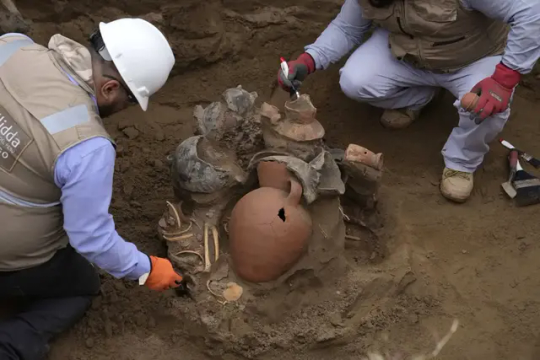
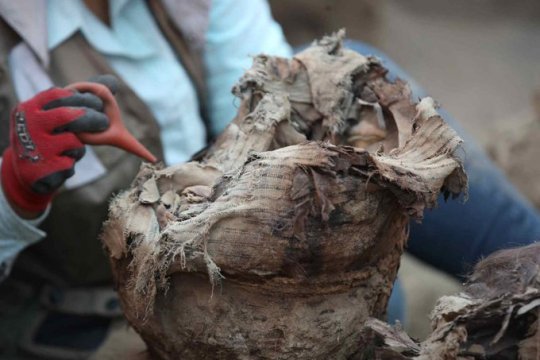

“When the Spaniards arrived in the 16th century they found an entire population living in the three valleys that today occupy Lima … what we have is a kind of historical continuation,” Bahamonde said.
Most of the archaeological sites uncovered by Calidda have been burial sites discovered on flat ground, Bahamonde said.
Aso scattered throughout the urbanized city are more than 400 larger archeological sites, known in the indigenous Quechua language as “huacas,” which are sacred adobe constructions typically found on hilltops.
By Patrick Reilly.

#Eight Mummies and Pre-Inca Artifacts Discovered in Peru#Lima Peru#ancient grave#ancient tomb#ancient artifacts#archeology#archeolgst#history#history news#ancient history#ancient culture#ancient civilizations#Inca history#Ichma history
56 notes
·
View notes
Text
In which cultures are emeralds particularly significant?

Because of their captivating green color, emeralds have long piqued the interest of civilizations and are held in high regard in many different cultures worldwide. \
Egypt in the past Emeralds were extremely valuable and regarded as a fertility and rebirth sign in ancient Egypt.
The Aztec and Incan Civilizations In South America's pre-Columbian societies, emeralds were extremely important, especially to the Incas and Aztecs.

Empire of the Mughals Emeralds were prized in India, especially during the Mughal Empire, for their purported therapeutic qualities in addition to their beauty.
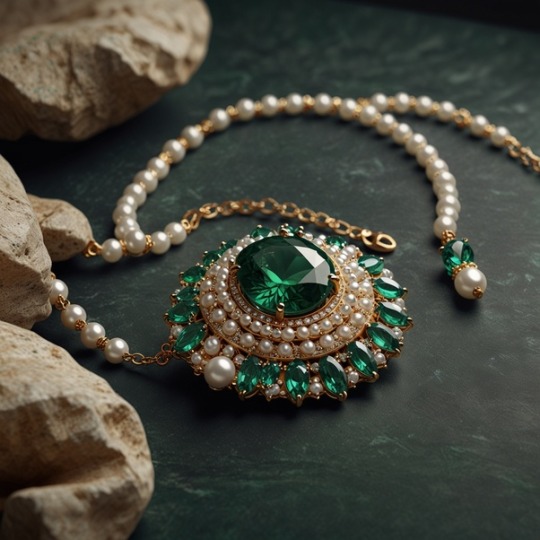
Royalty in Europe For a very long time, European aristocracy has been drawn to emeralds as a symbol of riches, power, and rank.

Contemporary Importance Emeralds are still highly prized in many cultures across the globe today.

#jewelrymaking#3dmodelofjewelry#jewelry#jewelrydesigner#jewelrycaddesigner#jewelry3d#jewerly#jewellery#Custom Jewelry
3 notes
·
View notes
Text
Pre-Columbian cultures:
Mexico: the ones who did the most flamboyant sacrifices (the Aztecs)
Guatemala: the ones who ran out of space in a calendar so everyone thought it was the end of the world (Mayans)
Colombia: the ones throwing solid gold in a lake to appease the gods (Chibcha)
Peru: the ones doing colonization before it was cool (Incans)
Ecuador: the ones who got colonized, AKA, Pre-Columbian Poland (Tawantinsuyu)
Venezuela: liked canoes too much because they liked fighting the Tainos (Arawaks)
Puerto Rico: the poor saps who first dealt with Columbus (Tainos)
11 notes
·
View notes
Text

Hey! I know I’ve been posting less frequently, but I wanted to talk to the Genshin Community to question something. (Just a random pic of Fontain for your viewing pleasure)
Where I got the photos!
(I am also not part of any of the affected cultures, but I am bringing this up because we are quite literally near the end of the line.)
Okay, so I want to talk about Natlan and the growing concern I have for the mishmashing cultures we will probs get yet again.

Here, we see that Genshin is trying to tackle both pre-colonial Mezoamerica and ideas of Spanish and West African cultures.
We know an example, Sumeru, where they have gotten backlash from the communities affected, and we know they work their hardest to show the cultural aspects of their stories as best they can with what they are given.
Sadly, this most likely will become like a Sumeru in my eyes, but I am hoping they try to at least make more darker skinned characters in Genshin soon, and give these characters curlier hair. But…
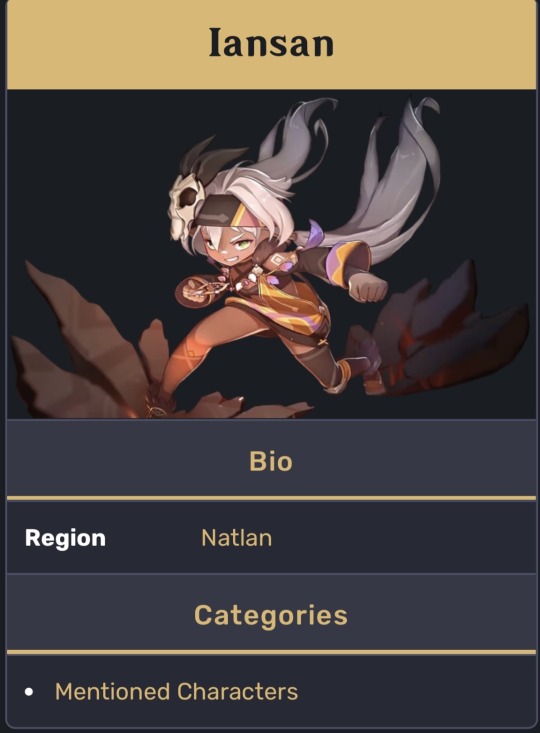
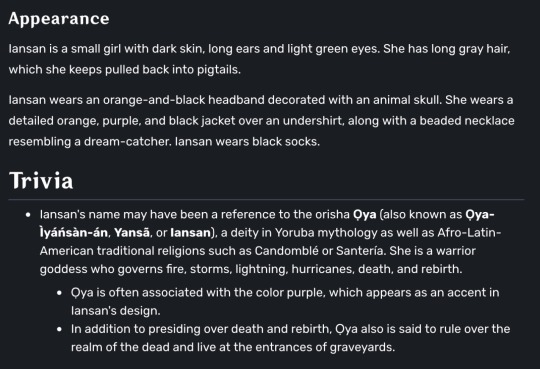
Can’t say I’m hopeful, especially since Murata is hypothesized to be Himeko, and while that is cool for people, It feels weird that a light skinned lady is the leader of a very diverse and dark skinned nation.
Iansan is based of Oya, a Yoruban and Afro-Caribbean Deity. I am not highly studied in the cultural elements, so I will not touch upon them, but I wonder how her character will turn out. But, I would like her to have had a Hydro vision because of the associated element with Iansan’s Deity counterpart.
Next…


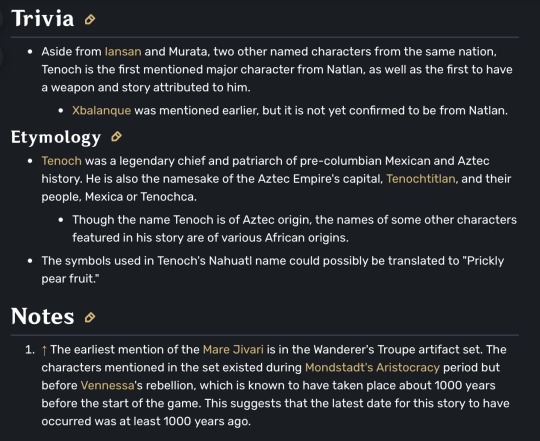
Tenoch is a main lore character of Natlan who had banded all the tribes together. He is based off of a chief of the Aztecs before, also banding together people like Tupac, Wenjiru, and Keyeke. Now, Tupac may make you think of Tupac Shakur the rapper, it is meant to refer to what they would refer to boys in the Incan Empire in Peru! Link.
When I looked up Wenjiru and Keyeke, I got a Kikuyu tale of a lady getting sacrificed and a literally noting aside for hypothetical origination in Nigeria. Ultimately, they most likely will fill this region with lore, but the over mixtures of cultures will cheapen the impact of representation. It’s like your wishing your feet to walk two ways.
Lastly: GENSHIN! GIVE US DARK SKINNED CHARACTERS! ESPECIALLY IN MONDSTADT!!!
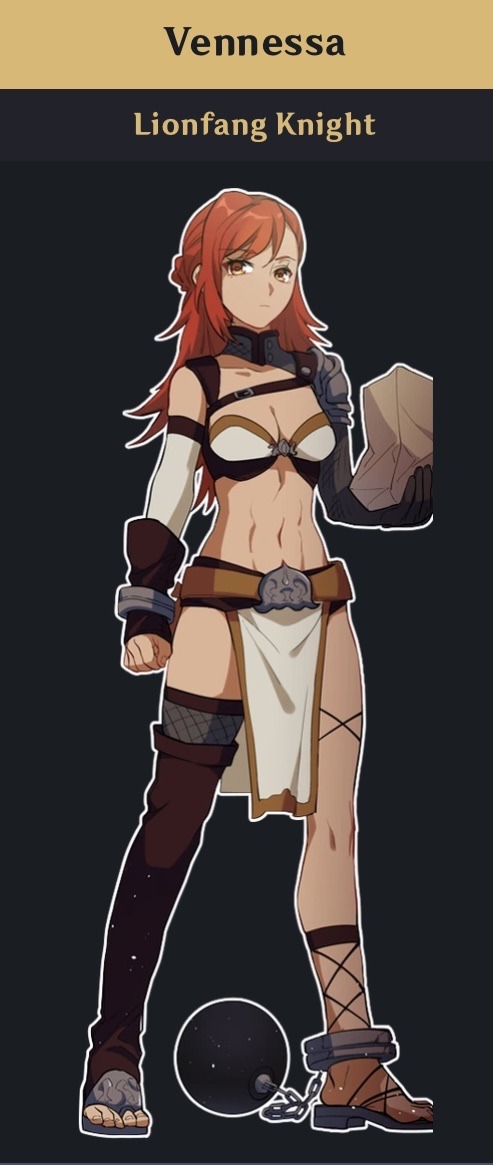
This has been a huge issue in my entire time playing Genshin and I cannot stop shutting up about this grave injustice because yes I need people to join my agenda. Where in the hell did the descendents of Venessas’s tribe go? Like, seriously, none of them are even represented in the game, unless I need to look into people’s backgrounds or something but like where is the descendants? Like, did they leave? Where did they go? Mihoyo? WHERE ARE THEY?
As always with these types of persuasive and not really informative content, take this with heaps of salt while researching for answers. Stay safe, stay cool, stay knowing, bye!
5 notes
·
View notes
Text
Trekking the Inca Trail with Alpaca Expeditions

Trekking the Inca Trail is one of the most iconic adventures in the world, and with Alpaca Expeditions, this unforgettable journey becomes even more meaningful and immersive. Winding through the breathtaking Andes Mountains, the trail offers a unique combination of natural beauty, ancient Inca ruins, and cultural richness that draws trekkers from across the globe. The final destination—Machu Picchu—is one of the New Seven Wonders of the World and a bucket-list goal for many.
It has earned a reputation for being one of the most trusted and sustainable trekking companies in Peru. Their expertly guided tours not only ensure safety and comfort but also provide deep insights into Incan history and culture. Unlike generic tour operators, they emphasize responsible tourism, hiring local porters and chefs, and using eco-friendly practices throughout the journey. Their dedication to supporting local communities and protecting the environment adds a layer of purpose to the trek.
The classic 4-day Inca Trail trek covers around 26 miles, beginning in the Sacred Valley and culminating at the Sun Gate overlooking Machu Picchu. Along the way, hikers encounter high mountain passes, lush cloud forests, and awe-inspiring archaeological sites like Wiñay Wayna and Phuyupatamarca. Each day brings new challenges and discoveries, from steep ascents to stunning vistas that seem straight out of a dream.

To prepare, trekkers should be in good physical condition and acclimatize to the altitude in Cusco before beginning. It provides pre-trek briefings, high-quality camping equipment, nutritious meals, and unparalleled service, making even the toughest parts of the trail more manageable.
For those looking for a truly transformative experience, trekking the Inca Trail is more than a hike—it's a journey through time and spirit. With Alpaca Expeditions, you'll not only walk in the footsteps of the Incas but also gain a deep appreciation for Peru's cultural heritage and natural wonders.
For more information
Mobile No : (+51) 84 254278
E Mail Id : [email protected]
Visit us : https://www.alpacaexpeditions.com/

0 notes
Text



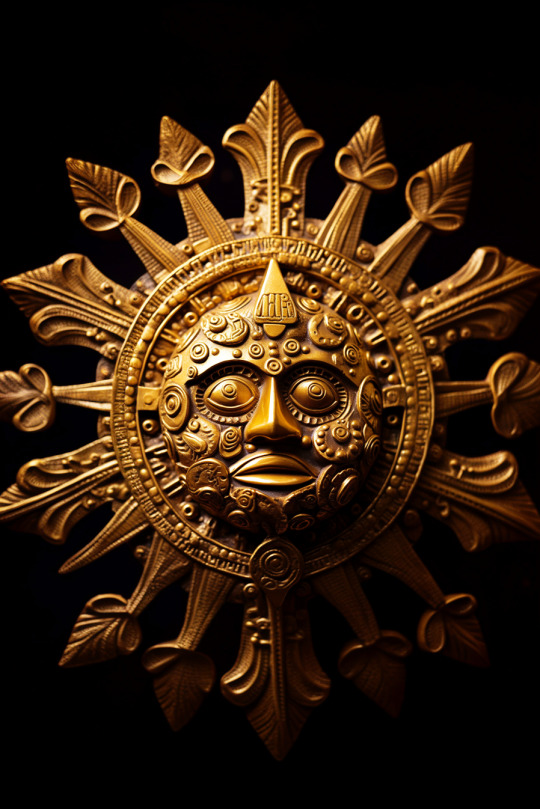
Viracocha: The Great Creator God of the Incas by Talon Abraxas
Considered the supreme creator god of the Incas, Viracocha (also known as Huiracocha, Wiraqocha, and Wiro Qocha), was revered as the patriarch god in pre-Inca Peru and Incan pantheism. His name was so sacred that it was rarely spoken aloud; instead replaced with others, including Ilya (light), Ticci (beginning) and Wiraqocha Pacayacaciq (instructor).
THE LEGEND OF VIRACOCHA
Legend tells us that a primordial Viracocha emerged out Lake Titicaca, one of the most beautiful and spiritually bodies of water in the world and located next to Tiwanaku, the epicenter of ancient pre-Hispanic South American culture, believed location of spiritual secrets found in the Andes. Viracocha is intimately connected with the ocean and all water and with the creation of two races of people; a race of giants who were eventually destroyed by their creator, with some being turned into enormous stones believed to still be present at Tiwanaku.
He re-emerged from Lake Titicaca to create the race most associated with humans as we understand them today. Satisfied with his efforts, Viracocha embarked on an odyssey to spread his form of gospel — civilization, from the arts to agriculture, to language, the aspects of humanity that are shared across cultures and beliefs.
While written language was not part of the Incan culture, the rich oral and non-linguistic modes of record-keeping sustained the mythology surrounding Viracocha as the supreme creator of all things. Now much-visited ruins, the distinct structures, and monoliths, including the architecturally stunning Gateway of the Sun, are testimony to the powerful civilization that reached its peak between 500-900 AD, and which deeply influenced the Incan culture.
30 notes
·
View notes